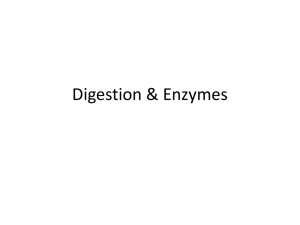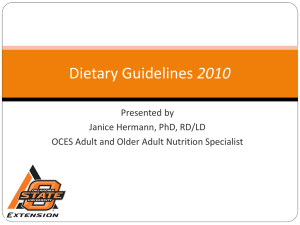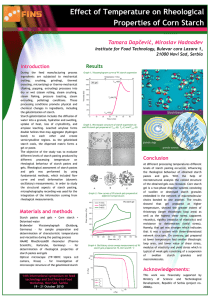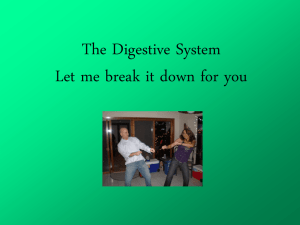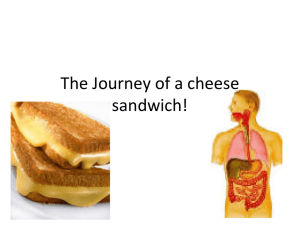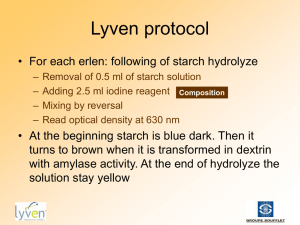IBS-2007-Winnipeg
advertisement
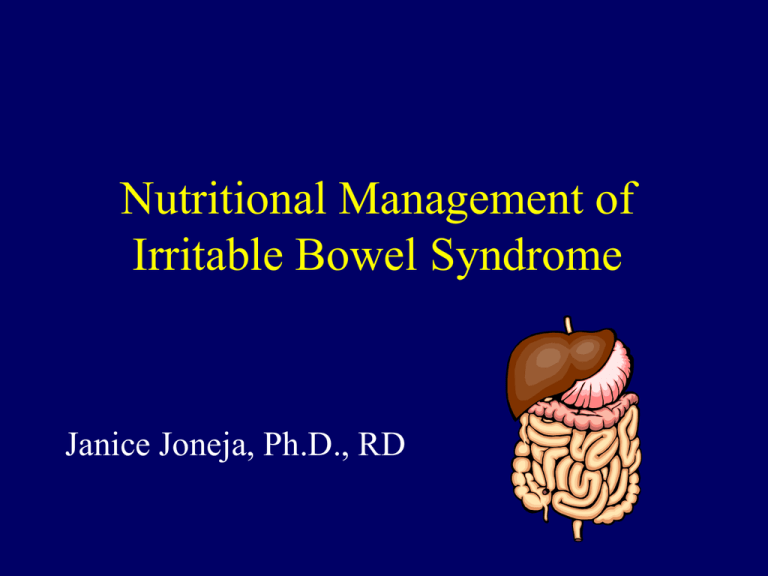
Nutritional Management of Irritable Bowel Syndrome Janice Joneja, Ph.D., RD Irritable Bowel Syndrome • Irritable bowel syndrome (IBS) tends to be an umbrella term for a variety of minor bowel disturbances of unknown origin • Sometimes called: – “irritable colon” – “spastic colon” 2 Symptoms of IBS • Symptoms include: – Change in bowel habit • often alternating constipation and diarrhea – Abdominal bloating and distension – Sometimes abdominal pain, frequently relieved by defecation – Feeling of incomplete defecation 3 IBS Characteristics • There is usually no sign of structural damage to the wall of the intestine (frequently indicated by blood in the stool) • Weight loss or nighttime fever are not experienced • A diagnosis of irritable bowel syndrome is made when all organic disease has been ruled out by appropriate medical tests • The Manning Criteria or the Rome II questionnaires are often used for diagnosis 4 Initial Triggers of IBS • Infection in the digestive tract: – Viruses – Bacteria – Parasites (amoeba; intestinal worms) • Pathology in the digestive tract – Inflammatory bowel disease – Coeliac disease • Surgical procedures in the digestive tract 5 Triggers of IBS (continued) • Stress: – Stress hormones are released – Neuropeptides may trigger the release of inflammatory chemicals • Hormone fluctuations: – Menstrual cycle – Pregnancy – Thyroid 6 Triggers of IBS (continued) • Change in types of micro-organisms in the large intestine due to: – Oral antibiotics – Other oral medications – Change in substrate (ie type of food passing into the bowel) • Alteration in microbial flora results in: – Different products resulting from the action of microorganisms on undigested food material: • Gases • Organic acids • Others 7 Mechanisms Responsible for Symptoms • Key factors in IBS resulting in symptoms include: – Inflammation • Resulting from release of inflammatory mediators – Increased sensitivity to pain • Neuropeptides (tachykinins) generated by the central nervous system interact with neurokinin receptors on the spinal cord • May also result from a response to inflammatory mediators (e.g. histamine) 8 Mechanisms Responsible for Symptoms (continued) – Motility dysfunction • Resulting from changes in autonomic nervous system signals • Resulting from products of microbial fermentation – Fermentation • Of undigested food in the large bowel • As a consequence of abnormal motility • As a consequence of altered microbial flora 9 Inflammation • Inflammation is rarely visible in tissue viewed under the microscope in IBS • However, there is research evidence of the presence of inflammatory activity in IBS, based on the presence of chemicals (e.g. PGE2) that indicate that inflammation is occurring 10 Causes of Inflammation in IBS • Infection: bacterial; viral; parasitic – Infective microorganism may have been successfully eradicated, but inflammation of the intestinal tissues may persist, especially as food is continually passing through • Autoimmune processes • Food protein enteropathy – Cow’s milk protein enteropathy – Soy protein enteropathy – Gluten-sensitive enteropathy (coeliac disease) • Food allergy and food intolerance 11 Stress and Inflammation • Neuropeptides are released into the digestive tract • Vasoactive intestinal peptide (VIP), Substance P, somatostatin, and others can cause degranulation of mast cells • Mast cells exist in large numbers in the digestive tract, and are intimately associated with nerves • Mast cells store inflammatory mediators designed to protect the body from invasion • Release of inflammatory mediators triggers inflammation 12 Altered Motility of the G.I. Tract • Altered speed of food passing through the G.I. tract can result in disturbance of the normal process of digestion and absorption of nutrients: – Increased speed in the small intestine results in incomplete breakdown of food components in the small intestine – Food is not in contact with digestive enzymes long enough for molecules to be broken down to the size and state required for absorption 13 Increased Motility in the Small Intestine • Incomplete breakdown of fats and oils by pancreatic lipases – Results in steatorrhoea (fatty stool) • Incomplete breakdown of carbohydrates – Results in complex sugars passing into the large bowel – Damage to cells lining the digestive tract results in deficiency of enzymes that digest sugars (lactase; sucrase; isomaltase) – Undigested sugars pass into the large bowel 14 Effects of Increased Motility in the Small Intestine • Incomplete protein digestion – Evidence of passage of fairly large polypeptides into circulation, especially if digestive tract lining is damaged by inflammatory processes – Undigested and unabsorbed proteins pass into large bowel – There are acted on by micro-organisms, resulting in production of organic acids, gases 15 Altered Motility in the Large Bowel • Increased speed through the large bowel results in watery stool as fluid is not resorbed – Causes diarrhea • Results in net fluid loss, with accompanying loss of electrolytes • Results in dehydration and electrolyte imbalance • Requires rehydration and restoration of electrolytes 16 Altered Motility in the Large Bowel (continued) • Decreased speed of movement through results in: – Increased microbial metabolism of food materials, resulting in production of: • Gases (hydrogen, carbon dioxide, methane, and others) • Organic acids • Other products of microbial activity – Increased resorption of fluid • Results in dry, hard stool • Constipation 17 Fermentation • All food materials not absorbed through the lining of the small intestine pass into the large bowel • Millions of bacteria colonise the organ • Perform “end-stage digestion” • Products of microbial activity can be important nutrients: – some B vitamins (pantothenic acid; biotin) – vitamin K 18 Colonic Fermentation • Plant foods contain two broad classes of carbohydrates 1. Free sugars (glucose, fructose, sucrose) 2. Polysaccharides • Free sugars are found mainly in fruit and vegetables and are rapidly absorbed from the small intestine in healthy humans • Sugar is also present in milk, in the form of lactose 19 Causes of Intestinal Symptoms: Carbohydrates • Non-digested carbohydrates pass into the large intestine causing: – Osmotic imbalance: causes excess fluid in the lumen of the large bowel resulting in loose stool – Increased bacterial fermentation resulting in production of: • organic acids (acetic, lactic, butyric, propionic) – increase osmotic imbalance • gases such as carbon dioxide and hydrogen – cause bloating and flatulence 20 Causes of Intestinal Symptoms: Carbohydrates (continued) – Increased bulk results in increased stool volume – Increased fluid and acid environment stimulate intestinal motility and accelerate intestinal transit time. – Increased speed of intestinal transit results in: • loose stool since fluid is not absorbed from food • Incomplete absorption of fat 21 Symptoms of Excessive Fermentation of Carbohydrate • Patients complain of abdominal fullness, bloating, and cramping pain, sometimes within 5-30 minutes, sometimes several hours after ingesting carbohydrate • Watery diarrhoea occurs from 5 minutes to 5 hours after ingestion • Excoriation of perianal skin and buttocks due to acid (pH less than 6) stool in children – Adults do not consistently experience such a low stool pH 22 Examples of Fermentation of Undigested Sugars: Lactose Intolerance • • Milk sugar, lactose, is digested by lactase enzyme produced in the cells lining the digestive tract Lactose is a disaccharide (double sugar) which cannot be absorbed through the lining of the digestive tract until it is broken down into its two single sugars (monosaccharides): – – • Glucose Galactose Lack of lactase reserves makes lactose particularly vulnerable to maldigestion 23 Sucrase-Isomaltase Deficiency • Primary deficiency is rare: it is inherited as an autosomal recessive gene • Greenland and Canadian Inuit have an unusual incidence of 10% of the population • Appears when sucrose enters the child’s diet, usually as fruit or fruit juice • Severity of symptoms depends on the quantity of sucrose in the diet • In practice sucrose must be avoided 24 Fermentation of Undigested Polysaccharides: Starch and Fibre • Plant polysaccharides can be separated into two broad categories: 1. Starch 2. Non-starch Starch is: – – a storage polysaccharide the major carbohydrate of cereal grains and potatoes Non-starch polysaccharides are: – – structural components of the plant cell wall considered the dietary fiber of foods 25 Starch • Starch is found in many of the world’s staple foods such as cereals, legumes, potatoes, and bananas • Usually starch in foods is readily digested in the small intestine by enzymes produced in the pancreas • The products of digestion of starch are absorbed into the body • The process can be speeded up by cooking: starch is gelatinized and rendered more available to the enzymes 26 Resistant and Non-resistant Starch • In the 1980s, research showed that a significant portion of dietary starch may resist digestion and pass intact into the colon • Food processing can render some starch partly resistant to enzymatic digestion • This was classified as resistant starch • Starch that is readily digested was called nonresistant starch 27 Resistant and Non-resistant Starch (continued) • All fibre and starch entering the large intestine is a suitable substrate for bacterial fermentation • Gas, bloating, pain may result from excessive microbial fermentation • Organic acids may be a source of irritation of mucosal tissues • Microbial fermentation of resistant starch and fibre can produce volatile fatty acids which are absorbed into the body from the colon, and may help in protecting against disease such as colon cancer 28 Resistant and Non-resistant Starch (continued) Cooking and processing can affect the digestibility of starch: • The quantity of some types of resistant starch in foods is critically dependent on processing conditions such as heating, cooling, freezing, or drying: – Starch from cereal products and freshly cooked potato is well digested – Cooled, cooked potato is less well digested than freshly cooked potato 29 Resistant and Non-resistant Starch (continued) • This may also occur with other starches such as rice and pasta • Up to 89% of the starch from raw banana escapes digestion in the small intestine • A high percentage of other raw fruits and vegetables may also be resistant to digestion in the small intestine and can provide a rich source of substrate for microbial fermentation 30 Comparison of Dietary Starch a) Fed b) Recovered after digestion in the small intestine Food Starch Fed (grams) Starch Recovered (grams) Percentage Starch Recovered (%) White bread 62 1.6 3 Oats 58 1.2 2 Cornflakes 74 3.7 5 Banana (raw) 19 17.2 89 Potato freshly cooked 45 cooled 47 reheated 47 4.5 5.8 3.6 3 12 8 Englyst and Kingman 1994 31 Factors Affecting Amount of Starch in the Colon • Cooking – Disrupts starch granules – Facilitates digestion by enzymes in saliva and the small intestine – When foods with a high level of resistant starch are eaten raw, more undigested starch passes into the colon • e.g. Banana – Retrograded starch increases on cooling: eat foods with high level of resistant starch when it is hot 32 Factors Affecting Amount of Starch in the Colon (continued) • Chewing – Amylase (ptyalin) in saliva is first enzyme to start process of starch digestion • The more the food is chewed, the greater the exposure of the starch to enzymes in the mouth and the small intestine • Speed of transit of food – The faster the food transits the small intestine, the less exposure to enzymes • High fat slows transit • High fluid (water with the meal) speeds the transit 33 Dietary Fiber “The sum of the non-starch polysaccharides in food” • Not affected by food processing • Includes a mixture of polymers such as cellulose, pectin, and hemicellulose • Resistant to human digestive enzymes and escape breakdown in the small intestine • May be classified as – “soluble” (becomes gelatinized in water, especially when heated) – “insoluble” (remains unchanged in water) 34 Dietary Fiber (continued) • Fibre resists digestion • All types of fibre pass completely undigested through the small intestine and into the colon • All carbohydrates that are not digested and absorbed from the small intestine move into the large intestine where they are fermented by micro-organisms 35 Accessibility of Starch and Fibre in the Colon • Physical accessibility • • • • Cell walls of plant cells entrap starch Prevents its swelling and dispersion Delays or prevents digestion by enzymes Includes whole grains, nuts, seeds: – vegetables with “skins”: sweet corn, peas, beans – partly milled grains and seeds: “whole grain” breads and cereals – If the rigid structures of the plant are physically removed, the starch is exposed to the action of enzymes in the small intestine 36 Role of Food in IBS • Food does not cause IBS • Food passing through “damaged organ” continues or exacerbates the condition • Food interacts with gastrointestinal tissues in several ways: – Immunologically – Physiologically – Biochemically 37 Diet for Management of Irritable Bowel Syndrome General Guidelines for Dietary Management of IBS 1. Reduce inflammation in all parts of the digestive tract – Avoid inflammatory triggers 2. Reduce the amount of fermentable substrate passing into the colon – Increase digestion and absorption in the small intestine 39 Dietary Management of IBS (continued) Triggers and exacerbators of inflammation include: – – – – – Allergens Chemicals that enhance release of inflammatory mediators (e.g. benzoates) Raw foods Alcohol Caffeine and other methylxanthines 40 General Instructions • It is important to eat a balanced diet complete in all essential nutrients • Eat three meals a day, with two or three snacks as desired • For each food avoided, substitute one of equal nutritional value • Supplemental micronutrients (vitamins and minerals) can be taken • Choose ones without additives (colour, sugar, preservatives) 41 Summary of Dietary Guidelines: Milk AVOID: All milk and milk products • Eliminate: – – – – – Milk Cheese of all types Yoghurt Butter Any food containing milk solids or derivatives • Consume protein to level usually consumed as milk products • Add calcium and Vitamin D supplements to ageappropriate level 42 Summary of Dietary Guidelines: Grains • AVOID: Specific cereal grains and flours: wheat, rye, oats, barley, and corn • Use alternative grains to provide equivalent nutrients: – – – – Millet Tapioca Arrowroot Sago – Quinoa – Amaranth – Rice 43 Summary of Dietary Guidelines: Fruit and Vegetables COOK All: – – • Vegetables (including salad vegetables) Fruits Fruit and vegetable juices Raw vegetables, raw salads, raw fruit, raw juices, are not allowed Corn is a grain, not a vegetable Substitute with: – – Tinned fruit Pasteurised juices 44 Summary of Dietary Guidelines: Spices and Herbs AVOID: Spices (root, seed, bark of plant); examples: – Cinnamon – Coriander seed – Curry spices – Mustard seed – Chilli seasoning spices – Pepper – Others Substitute with: • Herbs (leaves and flowers); examples: – – – – Thyme Sage Rosemary Oregano – Mint – Parsley – Others – Basil – Coriander leaves • Cooked garlic and ginger are allowed, if tolerated 45 Summary of Dietary Guidelines: Disaccharides Avoid: • Sucrose (Table sugar) – – – – – • Granulated Castor Demerara Brown Syrup of any type Substitute with: – – – Honey Fructose (“fruit sugar”; laevulose) Glucose (dextrose) is allowed but is not very sweet 46 Summary of Dietary Guidelines: Legumes AVOID: Legumes with indigestible, hard, outer skins; examples: – Dried peas and beans – Green peas, sugar peas, lima beans, broad beans Substitute with: Runner beans, French beans, yellow wax beans, green beans – Dried legumes without outer skins (lentils, split peas) – Legumes ground into flours (chick pea flour, soy flour, black or red bean flour) – 47 Summary of Dietary Guidelines: Nuts and Seeds AVOID: Whole nuts and seeds • Eat as “butters” (paste) only; examples – – – – – – Peanut butter (without any added sweeteners) Almond butter Cashew butter Sesame butter and tahini Sunflower seed butter Pumpkin seed butter 48 Summary of Dietary Guidelines: Meat and Fish AVOID: “Deli meats” such as: – Fermented sausages (salami, bologna, pepperoni, hot dog wieners) – Smoked meat or fish Cook all meats and fish from fresh or frozen sources – No breaded, battered, sweet cured meats – No smoked fish or meat – Do not add cream sauces 49 Summary of Dietary Guidelines: Fermented Foods and Beverages AVOID: Alcoholic beverages of all types AVOID: Vinegar and foods containing vinegar: – – – – Pickles Relish Prepared mustard Ketchup AVOID: Fermented foods such as: – – Sauerkraut Soy sauce 50 Summary of Dietary Guidelines: “Irritating” Foods and Beverages AVOID: Caffeine and benzoates Avoid coffees and regular tea – Herbal tea (without spices) are allowed. Some decaffeinated coffees contain chemicals to which sensitive individuals react – Note: If several cups of coffee or black tea are consumed per day, reduce intake gradually; sudden total withdrawal can produce unpleasant side effects 51 Summary of Dietary Guidelines: Vitamin and Mineral Supplements To ensure adequate intake of micronutrients, a multivitamin/mineral supplement is recommended Supplement should be free from: • Wheat • Yeast • Lactose • Corn • Additives such as artificial colours, flavours, and preservatives. 52 Summary of Dietary Guidelines (continued) – – – People differ in their degree of reactivity to some of the restricted foods Many individuals do not react adversely to vinegar and fermented foods Some people can drink coffee and eat chocolate but react adversely to tea (probably indicating benzoate sensitivity rather than a reaction to caffeine) 53 General Guidelines • The diet is initially followed for four weeks • If no improvement, keep a careful record of foods consumed and symptoms experienced for a further seven days • Based on the food/symptom record, increase restrictions for a further two weeks • If still no improvement, proceed to reintroduction of foods 54 Dietary Management of IBS • Clinical experience has shown that a certain degree of “healing” of the digestive tract may take place, and over time some of the restricted foods can be reintroduced into the diet • When the initiating circumstances are repeated (e.g. increased stress, recurrence of infection or pathology), returning to the basic IBS diet often again provides relief of GI tract symptoms 55 Dietary Management of IBS: The Next Stage If significant improvement is achieved open food challenge may be initiated • Use sequential incremental dose challenge (SIDC) to determine sensitivity and limit of tolerance to each eliminated food in its purest form • Symptom-free status may be maintained by avoiding the culprit foods and obtaining complete balanced nutrition from alternative sources 56 Probiotics in Management of IBS Lactobacilli, bifidobacteria and Streptococcus thermophilus, assist in reducing the symptoms of lactose intolerance • Produce the enzyme beta-galactosidase (lactase) in yogurt • Microbial lactase breaks down lactose • The fermented milk itself delays gastrointestinal transit, thus allowing a longer period of time in which both the human and microbial lactase enzyme can act on the milk lactose. 57 Microflora and Lactose Intolerance • Lactose tolerance in people who are deficient in lactase may be improved by continued ingestion of small quantities of milk • Does not improve or affect the production of lactase in the brush border cells of the small intestine • Continued presence of lactose in the colon contributes to the establishment and multiplication of bacteria capable of synthesizing the beta-galactosidase enzyme over time • Resident micro-organisms will break down the undigested lactose in the colon • Reduces the osmotic imbalance within the colon that is the cause of much of the distress of lactose intolerance 58
